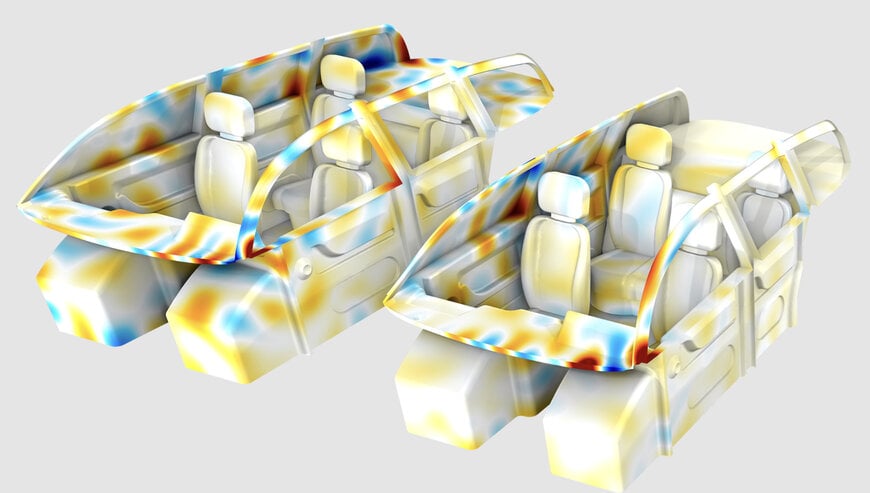www.ptreview.co.uk
19
'25
Written on Modified on
COMSOL Speeds Simulation with Expanded NVIDIA GPU Support for COMSOL Multiphysics Version 6.4
The latest multiphysics software adds GPU acceleration via NVIDIA’s CUDA direct sparse solver, plus Granular Flow and time-explicit structural dynamics modules.
www.comsol.com

COMSOL, a global leader in modeling and simulation software, announced the release of COMSOL Multiphysics® version 6.4, which introduces new features, major performance improvements, and expanded capabilities for multiphysics modeling and simulation app development. The latest version includes greatly improved solver performance through the NVIDIA CUDA® direct sparse solver, NVIDIA cuDSS, for NVIDIA AI infrastructure, the new Granular Flow Module, and a new framework for time-explicit dynamic analysis.
In addition to these major updates, geometry, meshing, and visualization workflows in COMSOL Multiphysics® have been enhanced, and productivity has been further advanced through optional large language model (LLM)-assisted simulation. The Chatbot window now supports connections to GPT-5™, DeepSeek™, Google Gemini™, Anthropic Claude™, and other OpenAI API-compatible models, enabling interactive, model-aware assistance that combines COMSOL documentation with information from the active simulation.
"Our goal with every release of COMSOL Multiphysics is to enhance the user experience and make it easier to achieve faster, more accurate modeling and simulation results," said Bjorn Sjodin, SVP of product management at COMSOL. "With added support for GPU-based solvers, the new Granular Flow Module, and explicit structural dynamics capabilities, we’re looking forward to seeing how users apply the platform to improve product designs and innovate. I’m particularly excited to see how GPU acceleration will speed up compiled simulation apps."
Faster Simulations with GPU-Accelerated Solvers
Version 6.4 of COMSOL Multiphysics® introduces NVIDIA GPU acceleration for direct solvers and extends multi-GPU capabilities for acoustics simulations. This update marks a major step forward in COMSOL’s continued work to improve solver performance and scalability.
cuDSS, a GPU-accelerated sparse direct solver optimized for hybrid CPU–GPU computation, supports all recent NVIDIA GPU architectures. Depending on the hardware and model characteristics, cuDSS can provide substantial speedups compared to CPU-based direct solvers. GPU acceleration is beneficial for both single-physics and multiphysics simulations, particularly in cases where solver robustness is important. In benchmarks, some multiphysics simulations have achieved speedups of 5x or greater.
"The integration of cuDSS into COMSOL Multiphysics marks a critical step in bringing accelerated computing to the heart of engineering simulation,” said Tim Costa, general manager of industrial engineering at NVIDIA. “Engineers can now explore larger design space with greater fidelity, reshaping how industries design, validate, and optimize the products that power our world.”
Additionally, NVIDIA CUDA-X cuBLAS library is accelerating the GPU formulation for transient pressure acoustics simulations which can now be run on multiple GPUs on the same machine, or even on a GPU cluster. These improvements reduce computation time significantly for larger models.
New Product for Simulating Motion and Interactions of Solid Particles in Bulk Processes
The Granular Flow Module, a new add-on product based on the discrete element method (DEM), enables engineers and researchers to model granular processes such as hopper discharge, silo storage, chute transport, powder spreading, and mixing. The Granular Flow Module applies to a variety of industries including pharmaceuticals, chemical processing, agriculture, mining, and additive manufacturing, among others.
By capturing particle-scale effects such as collisions, adhesion, and rotational resistance, and providing detailed control over grain properties, release conditions, and wall interactions, the module helps users evaluate flow uniformity, packing density, mixing efficiency, and wall stresses — revealing issues like blockages or uneven flow to support better process design and optimization.

The new Granular Flow Module can be used to analyze mixing performance and quantify homogeneity in industrial blending equipment.
More Efficient Simulation for Time-Explicit Dynamic Analysis
Version 6.4 also introduces a new framework for time-explicit dynamic analysis, enabling efficient simulation of fast, transient, and highly nonlinear events such as impact, crushing, and elastic wave propagation. The explicit formulation supports a wide range of nonlinear structural materials, including hyperelastic, plastic, viscoplastic, and creep models, and can also be combined with dynamic fracture simulations. To streamline model setup for complex mechanical assemblies, new functionality automatically detects and defines contact conditions between interacting parts.

Explicit structural dynamics capabilities enable a new class of simulations in COMSOL Multiphysics® version 6.4, including drop tests of handheld consumer electronics.
News Across the Product Suite
Additional highlights of COMSOL Multiphysics® version 6.4 include:
- Higher-quality quad-dominant meshing and swept meshing
- Spatially varying transparency
- Array-based plot layouts
- More efficient building of large simulation apps
- New optimization options for time-dependent and parametric studies
- Export of network parameters for deep neural network (DNN) surrogate models
- Surrogate model data generation on clusters
- Import of CFD data in CGNS format
- Frequency- and time-dependent uncertainty quantification

